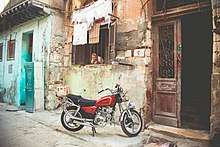Kom El Deka
Kom El Deka (Arabic: كوم الدكة) is a neighborhood in Alexandria, Egypt. [1] Archaeological Site in Alexandria, Kom Al Dikka was a well-off residential area in Graeco-Roman times, with lovely villas, bathhouses and a theatre. The area was known at the time as the Park of Pan, a pleasure garden where citizens of Alexandria could indulge in various lazy pursuits. Although the ruins aren't terribly impressive in scale, they remain a superbly preserved ode to the days of the centurion and include the 13 white-marble terraces of the only Roman amphitheatre found in Egypt.[2] It contains a historical theater that dates back to the Roman era.
Kom El Deka كوم الدكة | |
|---|---|
 Kom El Deka Location in Egypt | |
| Coordinates: 31.196687°N 29.90564°E | |
| Country | |
| Governorate | Alexandria |
| City | Alexandria |
| Time zone | UTC+2 (EST) |

Current archaeological research
Archaeological research on Kom el Deka was initiated in 1960 by Prof. Kazimierz Michałowski. At present, the work is still conducted by a Polish-Egyptian archaeological and conservation expedition from the Polish Centre of Mediterranean Archaeology University of Warsaw (PCMA UW) and the Egyptian Ministry of Tourism and Antiquities (formerly Ministry of Antiquities). The current project director is Dr. Grzegorz Majcherek from the PCMA UW.[3]
Archaeological discoveries
In the magnificent, richly-decorated residences, which dominated the site in its heyday (1st–3rd century), archaeologists found wall paintings with depictions of Alexander the Great, sculptures, and mosaics.[3] An exceptional group of multicolored mosaics was discovered in the so-called Villa of the Birds, dated to the 1st century.[4] They are beautifully decorated with images of birds as well as figural and geometrical motifs. In the later period, the residences were replaced by more modest houses which served several families; workshops were set up as well.[3]
The end of the 4th century saw the construction of imperial baths, a huge complex typical of the Eastern Mediterranean: compact and symmetrical with a rectangular floor plan. However, some of the rooms, e.g., the frigidarium and caldarium, resembled more those of North African thermae. The roofing, presumably made of wood, was not preserved. The complex was probably partly destroyed during an earthquake in 535 and then rebuilt.[5]
In 1964, excavations started in the Roman theater discovered during construction works. Restoration of the structure began two years later. The theater, like the baths, was built in the 4th century. In the 6th century, it was entirely remodeled and became an auditorium.[6]
Another remarkable feature of the site is a complex of auditoria dated to the 5th–7th century, the first ancient “university” to be discovered. It consisted of about 20 lecture halls, and the academy also reused the old theater for its purposes.[6]
Since 2017, tourists can visit the most important parts of the site.[7] The archaeological park on Kom el-Deka was designed by architect Wojciech Kołątaj, who had directed the archaeological expedition for several years and had reconstructed many of the buildings. For these achievements, he received the Professor Jan Zachwatowicz Award, presented by the Polish Committee of ICOMOS.[8]
See also
References
- Grzegorz Majcherek. Alexandria. Kom el-Dikka. Season 2017. Polish Archaeology in the Mediterranean, 27/1 (2018), 35–56
- Grzegorz Majcherek. Crumbs from the table – archaeological remains of Hellenistic Alexandria. In Hellenistic Alexandria. Celebrating 24 centuries. International Conference, Athens, 12–15 December 2017, Acropolis Museum (pp. 71–85). Oxford: Archeopress 2018.
- Wojciech Kołątaj, Grzegorz Majcherek and Ewa Parandowska. Villa of the Birds: The excavation and preservation of the Kom al-Dikka mosaics (=American Research Center in Egypt Conservation Series 3). Cairo: American University in Cairo Press 2007.
- Zsolt Kiss, Grzegorz Majcherek, Henryk Meyza, Henryk Rysiewski and Barbara Tkaczow, B. Fouilles polonaises à Kôm el-Dikka (1986–1987) (=Alexandrie 7). Warsaw: Centre d’archéologie méditerranéenne de l’Académie polonaise des sciences 2000.
- Barbara Tkaczow. The topography of ancient Alexandria: An archaeological map. Warsaw: Zakład Archeologii Śródziemnomorskiej, Polskiej Akadmii Nauk 1993.
- Wojciech Koła̜taj. Imperial baths at Kom el-Dikka (=Alexandrie 6). Warsaw: Zakład Archeologii Śródziemnomorskiej Polskie Akademii Nauk 1992.
Footnotes
- "Kom Al Dikka | Alexandria, Egypt Attractions". Lonely Planet. Retrieved 2020-06-04.
- "محمد عبد الستار الأبيض - حي كوم الدكة التاريخي". الحوار المتمدن. Retrieved 2020-06-04.
- "Alexandria, Kom el-Dikka". pcma.uw.edu.pl. Retrieved 2020-06-04.
- Wojciech Kołątaj, Grzegorz Majcherek and Ewa Parandowska. Villa of the Birds: The excavation and preservation of the Kom al-Dikka mosaics (=American Research Center in Egypt Conservation Series 3). Cairo: American University in Cairo Press 2007.
- Stefan Jakobielski and Janusz Karkowski (Eds.) Fifty Years of Polish Excavations in Egypt and the Near East, Acts of the Symposium at the Warsaw University 1986, Varsovie 1992
- Ewa Laskowska-Kusztal (ed.), Seventy Years of Polish Archaeology in Egypt, Warsaw: PCMA, 2007
- "Kom el-Dikka, Alexandria: opening of the visitors' route". pcma.uw.edu.pl. Retrieved 2020-06-04.
- "Conservation award for PCMA architect". pcma.uw.edu.pl. Retrieved 2020-06-04.